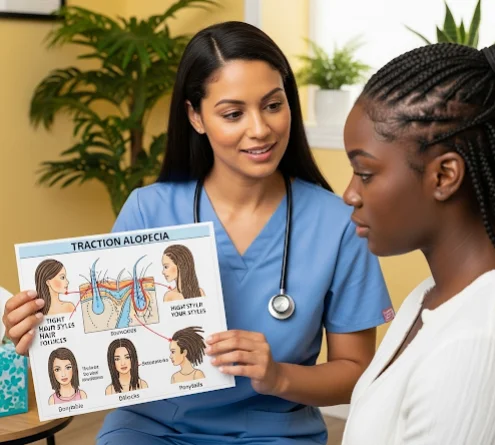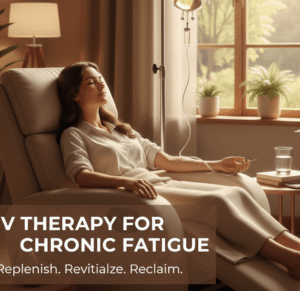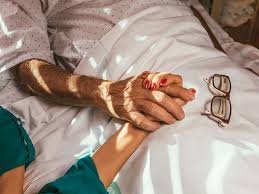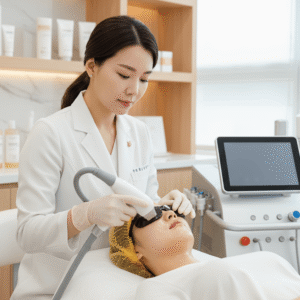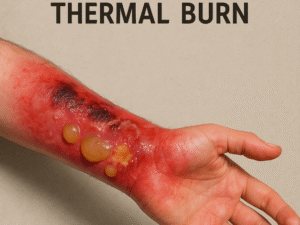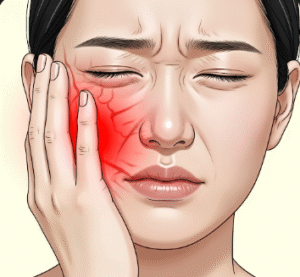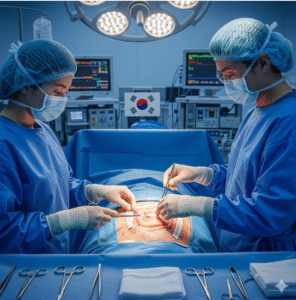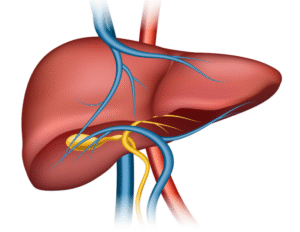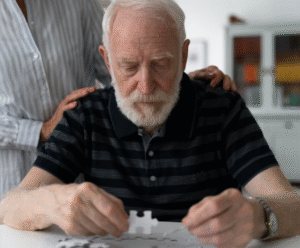What it is
➝ Traction alopecia (TA) is a form of hair loss caused by chronic pulling or tension on the hair follicles.
➝ It is commonly seen along the frontal hairline, temples, and sides of the scalp, but can affect any area exposed to sustained traction.
➝ Typical causes include tight hairstyles (ponytails, braids, buns), hair extensions, rollers, wigs, or cultural grooming practices.
➝ In Korea, traction alopecia is increasingly recognized due to frequent styling, chemical treatments, and aesthetic hair procedures. Counseling is an essential part of preventing progression and guiding recovery.
Why it’s done
→ To educate patients on the reversible nature of early traction alopecia.
→ To help patients modify hairstyles and grooming habits that cause follicular damage.
→ To prevent progression to permanent scarring alopecia, which occurs in long-standing cases.
→ To improve cosmetic appearance and self-esteem through early lifestyle intervention and treatment.
Alternatives / Adjunctive Therapies
→ Hairstyle modification: avoiding tight ponytails, braids, extensions, and rollers.
→ Topical minoxidil: stimulates regrowth in viable follicles.
→ Oral minoxidil (low-dose): considered in resistant cases in Korea.
→ Intralesional corticosteroids: for inflammation around hairline.
→ Platelet-rich plasma (PRP): used in some Korean hair clinics for follicle stimulation.
→ Hair transplantation: option for advanced, scarring traction alopecia once inflammation is controlled.
Preparation
→ Clinical diagnosis by history and exam (hairline recession, broken hairs, perifollicular erythema).
→ Trichoscopy may show miniaturized hairs, follicular dropout, and perifollicular scaling.
→ Baseline photography to track regrowth after interventions.
→ In Korea, clinics often combine digital trichoscopy and scalp imaging to document early changes.
How it’s Done – Counseling Approach
→ Step 1: Education – Explain that traction alopecia is preventable and often reversible if addressed early.
→ Step 2: Hairstyle guidance – Recommend looser hairstyles, alternating styles, and avoiding long-term extensions or tight wigs.
→ Step 3: Haircare modification – Reduce use of chemical relaxers, heat styling, and frequent dyeing.
→ Step 4: Medical therapy – Introduce topical/oral minoxidil or intralesional steroids if early follicular damage is visible.
→ Step 5: Long-term plan – Encourage routine scalp monitoring with trichoscopy and consider PRP or transplantation if advanced.
Recovery
→ Early traction alopecia can show visible regrowth within 3–6 months once traction is removed.
→ Patients may notice less shedding within weeks of modifying hairstyles.
→ Advanced scarring alopecia does not regrow spontaneously; transplantation is the only definitive option.
→ Psychological reassurance is crucial, as cosmetic concerns are often significant.
Complications
→ Permanent scarring and follicle loss if tension continues for years.
→ Pigmentary changes and scarring at the hairline.
→ Psychological stress due to visible hairline recession.
Treatment Options in Korea
→ Korean hair clinics provide structured counseling sessions focusing on hairstyle modifications and hair health education.
→ Topical and oral minoxidil are widely prescribed for early traction alopecia.
→ Intralesional steroid injections are used when perifollicular inflammation is present.
→ PRP therapy is popular in Korean cosmetic dermatology centers for stimulating regrowth.
→ Hair transplantation is offered in advanced cases, with careful graft design to restore natural hairlines.
→ Korean dermatologists integrate digital imaging and AI trichoscopy to monitor progress and improve patient compliance.
→ With Korea’s combined cosmetic and medical dermatology infrastructure, traction alopecia patients receive both preventive education and advanced treatment options, balancing hair health with aesthetic goals.

